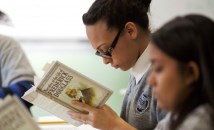By Dave Levin, KIPP Co-Founder
The central idea behind focusing on classroom ratios is to ensure that our students are doing as much of the heavy cognitive lifting and having the most engaging experience as possible in our classes. There isn’t one “right” ratio. Ratios vary by age of student as well as our individual strengths as teachers. That being said, the goal of maximizing the effectiveness of every moment we spend with our students remains constant across our PreK-16 and beyond continuum.
In Seven Habits of Highly Effective People, Stephen Covey shares this quote from Bruce Barton: “Sometimes when I consider what tremendous consequences come from little things, I am tempted to think there are no little things.”
The three ideas below draw from the following KIPP Framework for Excellent Teaching (KFET) competencies: joy, ratio, and rigor. We’re also always looking for ideas and feedback about how we might develop a possible set of ratios for the various parts of a lesson. We’ve included a hypothesis at the end of this piece and would love your thoughts. Email me at blog@kipp.org.
Three Ratios for Success
1) Positive Interaction Ratios:
The ratio of our positive interactions to our negative ones impacts both joy and learning.
Research by Barbara Frederickson and Marcial Losada has found that the ratio of positive to negative interactions have a profound impact on someone’s cognitive as well as emotional well-being. They found that positivity “equips individuals with the adaptive bias to approach and explore novel objects, people, or situations.”
According to their research, normal human function is characterized by a ratio of 2.5 positive interactions for every 1 negative one. This ratio climbs to 4.3 to 1 for optimal functioning, and then 5 to 1 for successful marriages :). It’s important to note that these interactions are often less than 3 seconds.
Four thoughts to increase positive interactions tomorrow:
1. Smile more
2. Circulate the room more during lessons noticing and commending positive behaviors and work
3. Use kid’s name more when praising work or behavior in one on one interactions (remember growth mindset praise focuses on effort and actions)
4. Click for Constructive Responding guide
Misconception Alert:
Every interaction must be positive (misconception). Remember this is a ratio. According to research by Daniel Kahneman there are 20,000 moments in the day. This means there is plenty of room for negative interactions 🙂 – we are just looking to have the ratio tilt more in the positive direction.
2) Questioning Ratios:
Increase the ratio of varied questioning techniques (playing basketball) to static questioning (playing catch) and the ratio of higher level questioning to lower level questioning.
Think of static questioning as a game of catch between the teacher and one student at a time and varied questioning as techniques that have students talking in a variety of different formats (to the teacher, to each other, whole-group oral response, raise your hand if…, in writing to each other, etc…)
Some varied questioning techniques include (For more on certain of these see Doug Lemov’s Teach Like a Champion):
– Call and response
– Pre-call – alert a kid that you are going to call on them next
– Cold call – call on kids without warning
– Half-statements – means you start a statement and then stop mid-way which is a signal for the kids to raise their hands to finish your thoughts
– Fill in the blank
– What’s next/what comes before
– Unbundling – breaking a complex idea into its components.
– Elaborating or building on
– Why/how
– Testing the logic
– Playing dumb – intentionally making mistakes to see if the kids catch them
– Steering cues
– Asking students whether they agree or disagree with another student’s answer
Try elaborative interrogation (coined by Robert Marzano) and Stretch-it (coined by Doug Lemov) to increase ratio of higher-order thinking questions.
Elaborative Interrogation: Forces student to “prove,” “justify,” or “defend” their answers and those of their classmates in a positive manner (of course).
Some Elaborate Interrogation strategies include:
– “What are some typical characteristics you would expect of ______________”
– “What would you expect to happen if__________________________”
– “Why would that be true?” “How do you know that is true?”
– “Tell me why you think that is so?”
– “It seems to me that you are saying _________________”
Stretch-It (from Lemov’s pp.41-47): Reminds us not to stop with simple, correct answers but rather to push students to answer follow-up questions that extend knowledge or test for reliability/correctness (both of their own answers and those of their classmates).
Some Stretch-It strategies include:
– Ask How or Why
– Ask for Another Way to Answer
– Ask for a Better Word
– Ask for Evidence
– Ask Students to Integrate a Related Skill
– Ask Students to Apply the Same Skill in a New Setting
Four thoughts to improve questioning ratios tomorrow:
1. Try one of the strategies from the varied questioning list (my personal favorites are half-statements and a combination of pre-call and cold-call.
2. Try another one!
3. Try one strategy from Elaborative Interrogation (my personal favorite is “how/why do you know that is true/the case or false/not the case?”)
4. Try one “Stretch-It” strategy (my favorite here is asking for evidence).
Misconception Alert:
Every question needs to use a ratio strategy (misconception). You need to use these strategies to balance the needs of rigor, engagement, and pacing and timing. If you did a ratio strategy every time, you’d run out of time.
Misconception Alert #2:
These strategies apply only to oral questioning (misconception). These apply just as much to the written questions we structure for kids. Again, we must be cognizant of pacing and timing in all of the decisions we make as teachers.
3) Doing the Work Ratios:
Increase ratio of independent practice compared to guided practice.
Are we having enough sustained, structured, and rigorous independent practice so that our students have sufficient “at-bats” to develop and demonstrate mastery of what they are learning? Toward that end, independent practice allows us to have time in class to work deeply with individual/small groups of students on their level – those who are struggling, those on level, and those ahead. Providing real-time feedback on the quality of work is an essential part of maximizing the effectiveness of student practice.
Four thoughts for increasing the work done by our kids (you could start these tomorrow although some will take time to set up 🙂 :
1. Use a timer to keep a hard target for your opening routine and guided practice.
2. Set the expectations for and establish a routine for which kids you are going to work with during independent practice – try working either with a small group or an individual student for an extended time as opposed to hopping from student to student.
3. Create a chart to track the total time kids spend working independently every day.
4. Clearly explain to students what they are supposed to do when they are finished (when in doubt, try reading silently).
Misconception Alert:
More independent practice is always a good thing (misconception). There can be too much independent practice in a class by which teachers are not providing enough guidance or examples to feedback.
Misconception Alert #2:
Independent Practice requires less planning (misconception). Effective independent practice requires actually more planning because it must be differentiated for the multiple levels in our classroom and it also must be clear enough that there aren’t a bunch of questions from students about what they are supposed to do.
A Working Hypothesis of the Effective Classroom Ratio
(Very early draft and likely to change over time.)
For the past several years, a large group of us have been talking, analyzing videos, and thinking through the ratio of how the various elements of a lesson plan are executed in our classes.
There are several HUGE asterisks here:
1. These are our current best thinking and will most likely change slightly in the months ahead as we do more work on this.
2. There are a ton of subset skills, routines, stamina that need to be taught to bring these percentages to life. We will not be able to do this overnight nor will kids.
3. There will also be individual variations on how this looks from class to class (i.e. more inter-woven guided/independent practice, more independent practice, or certain lessons that require a larger guided part). Ideally the percent of GP and IP both go up.
4. This is currently based on work with MS and HS teachers. Over the next 18 months we are going to be doing a lot of work to see how this looks in ES.
5. As mentioned in #2, hitting these targets is hard.
Potential Effective Classroom Ratios Outline
A. Opening Routine: Absolutely no more than 15% of the class
(entrance, do now – including reviewing do now, homework check).
i. 50 minute class ≤ (less than or equal to) 7.5 minutes
ii. 75 minute class ≤ 11.25 minutes (although it seems logical that this should still be ~10 minutes)
iii. 90 minute class ≤ 13.5 minutes (although it seems logical that this should still be ~10 minutes)
Remember – This includes completing entrance do now (if applicable), going over do now (if applicable, and whatever HW checking routine exists. An opening routine that is too long is one of the primary ways that a class period can be messed up.
B. Intro to new material/guided practice: Less than or equal to 25% of the class
i. 50 minute class ≤ (less than or equal to) 12.5 minutes
ii. 75 minute class ≤ 18.75 minutes
iii. 90 minute class ≤ 22.5 minutes
Remember – This means SMART aims/objectives.
C. Independent Practice: Greater than or equal to 33% of the class
i. 50 minute class ≥ (greater than or equal to) 16.5 minutes
ii. 75 minute class ≥ 24.75 minutes
iii. 90 minute class ≥ 29.7 minutes
Remember at least 5 keys here:
1. As mentioned above, SMART Aims
2. Lesson plans that clearly map out independent practice.
3. Teachers are using this time to work with individual and small groups of kids in a structured fashion
4. Stamina needs to be built and taught. Depending on the nature of the lesson, IP can be in a couple of chunks with GP in between.
5. Super clear routines and expectations also need to be in place (particularly around what students do if they have questions, want their work checked, are finished, etc…)
D. Review of Independent Practice, Evaluation, and Closure: Less than or equal to 22% of the class
i. 50 minute class ≤ (less than or equal to) 11 minutes
ii. 75 minute class ≤ 16.5 minutes
iii. 90 minute class ≤ 19.8 minutes
E. Transitions, HW distribution, exit, etc.: Absolutely no more than 5% of the class
i. 50 minute class ≤ (less than or equal to) 2.5 minutes
ii. 75 minute class ≤ 3.75 minutes
iii. 90 minute class ≤ 4.5 minutes
Misconception Alert: Every lesson needs to have these ratios (misconception). Some lessons will require slightly more of one part of the lesson plan than another – the above are average targets to aim for across the typical lessons and across the course of a week.
Additional Resources:
Four books that will help you explore different aspects of ratio, rigor, and joy include:
–The Skillful Teacher by John Saphier
–Teach Like a Champion by Doug Lemov
–The Art and Science of Teaching: A Comprehensive Framework for Effective Instruction by Robert Marzano
–Mindsets by Carol Dweck.
Shout Outs:
The above ideas have evolved over a number of years through conversations with and observations of countless remarkable teachers, particularly: Sarah Campbell, Frank Corcoran, Caleb Dolan, Amber Field, Whitney Grese, Mayme Hostetter, Brent Maddin, Jeana Marinelli, Joe Negron, and Kelly Wright.





